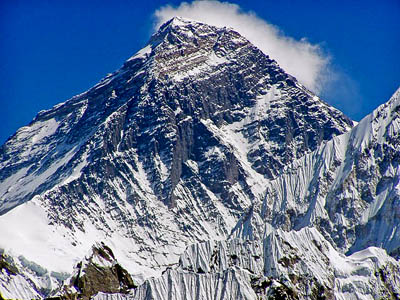In 1852, an Indian surveyor and mathematician Radhanath Sikdar, clearly calculated that a distant peak in the closed kingdom of Nepal – formerly known as Peak B and then renamed Peak XV – was the highest in the world.
Given that the measurements taken on large theodolites by his colleagues working on the Great Trigonometric Survey of India were at a distance of 190km (120 miles) from the mountain, they proved subsequently to be remarkably accurate, giving a height of 8,839.2m (29,000ft).
In the intervening century and a half, the highest point above sea level on planet earth has undergone much conjecture and discussion, ranging from its different names to the actual height of the mountain.
Local Sherpas had always known the mountain as Chomolungma, but since the staff of the Great Trigonometric Survey were not allowed access to the area and could not at the time determine its local appellation, they called it Mount Everest, after the former Surveyor General of India Colonel Sir George Everest. Even this was controversial – Everest himself resisted the idea, insisting native names should be applied to mountains and, even today, the western name for the world’s highest mountain is said differently from the man whose name it took. Sir George’s name was pronounced ‘eev-rest’.
As for the height of Everest, or Chomolungma, or Qomolangma or Sagarmatha, that too has been the subject of argument for decades – an argument settled recently, sort of, by the Nepalese and Chinese governments.
The height of Everest is now officially 8,848m – or 8,844m. The former is the height always stated by Nepal and marks the height of the snow and ice cap on the peak. The latter, the preferred figure for the Chinese government, which occupies Tibet on the north side of the mountain, which is another bone of contention, relates to the height of the actual rock underlying the snow.
In a typical diplomatic compromise, the two administrations have agreed to accept each other’s figures. If we’re being pedantic, the rock height is actually 8,844.43m.
So there we are: that’s agreed – a compromise. As most summiteers will definitely not be standing on the rock, it’s fair to say their feat will entail climbing to 8,848m, though it may vary a bit depending on how much climate change affects the depth of ice and snow. So those brave men and women following in Hillary and Tenzing Norgay’s steps will be standing 29,028ft 10½ins above the sea.
Except that tectonic movement may be pushing Everest’s peak 4mm – about one-sixth of an inch – higher each year. Or it may actually be shrinking.
Now, where are John Barnard, Graham Jackson and Myrddyn Phillips and their Leica gear when you need them?

Zainul
23 April 2010I have read this article attentively.I like to pay my respect to the mathematician,Radhanath Sikdar, who clearly calculated
the height of the highest peak long ago with the available apparatus.I request all to exercise his/her best and become memorable some day later in their life.
Lisa, South Africa
05 June 2010Some time ago (perhaps a two or three years ago) the height of Everest was remeasured to 8850m, give or take a few centimetres...